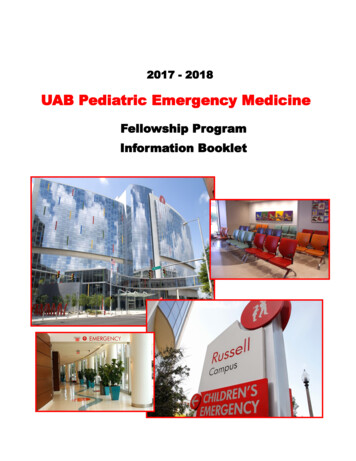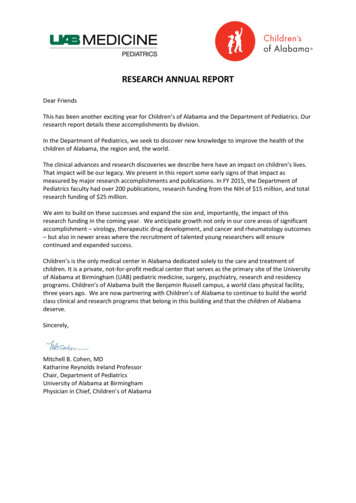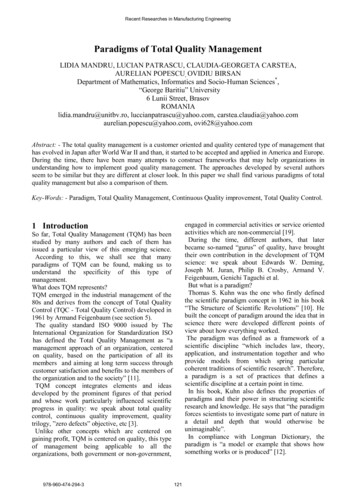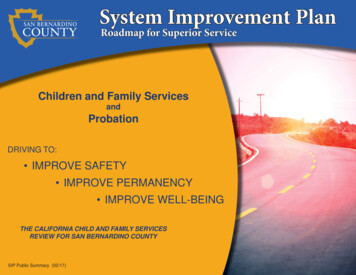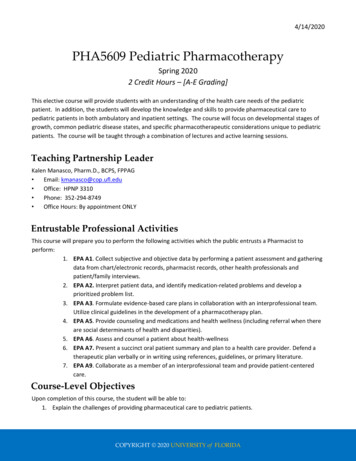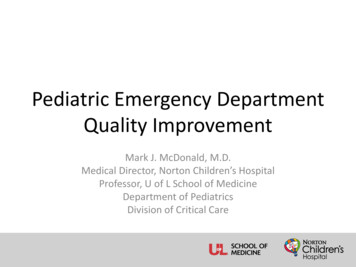
Transcription
Pediatric Emergency DepartmentQuality ImprovementMark J. McDonald, M.D.Medical Director, Norton Children’s HospitalProfessor, U of L School of MedicineDepartment of PediatricsDivision of Critical Care
Objective Present ideas and examples for pediatric QIactivities to initiate at Kentucky EmergencyDepartments
QI Barriers
QI Barriers TimeEffortPeopleDiscoverable in KentuckyPeople don’t want to talk about itRequires willingness to change
Why Is Quality and SafetyImportant? 2000 Institute of Medicine report “To Err isHuman: Building a Safer Health System”estimated between 44,000 to 98,000 peopledie each year due to preventable medicalerrors
Why? Unexplained clinical variationEvidence based careRefuse to standardizeMD autonomyMD focus on a single organ system, singlepatient, their way of doing things No focus on population health
Unexplained Clinical Variation
Unexplained Clinical Variation CXR, labs, CVL care, abx, diagnoses, hand offs Create stable processes Guidelines Protocols/standing orders
JAMA Pediatr. 2015;169(6):527-534
Kentucky ED QI
Importance of QI in Hospitals that seefewer Pediatric Patients Deficiencies in pediatric readiness in the emergencydepartment Limited pediatric experience (particularly with critically ill andinjured children) Smaller proportion of visits, less system “readiness” Lack of pediatric competency requirements for providers Weight-based dosing requiring measurement and calculation
KY KPECC criteria The Quality Improvement/PerformanceImprovement (QI/PI) plan shall includepediatric-specific indicators, and the pediatricpatient care-review process must beintegrated into the ED QI/PI plan. Componentsof the process should interface with EMSand/or other pre-hospital providers, ED,trauma, inpatient pediatric, and hospital-wideQI or PI activities.
At a minimum, QI/PI facilitators should: 1. Identify pediatric-specific indicators of goodoutcome. 2. Collect and analyze data monthly to discovervariances. 3. Define plans for improvement. 4. Evaluate or measure the success of the QI or PIprocess. 5. Mechanisms should be in place to monitorprofessional performance, credentialing, continuingeducation, and clinical competencies includingintegration of findings from QI audits and casereviews.
BASELINE DATA
Emergency Department PediatricPerformance Measures Toolbox s-toolbox/ 11 areas of interest 60 performance measures
Emergency Department PediatricPerformance Measures Toolbox Initial Care for Every Emergency Department PatientEmergency Department Infrastructure and PersonnelPatient-Centered Emergency Department CareEmergency Department FlowPain and SedationSevere IllnessTraumaRespiratory DiseasesOther ConditionsChildhood InfectionsQuality and Safe Care for All Patients
National Benchmarking NACHRI ED focus groupCHAVPSSTSPC4NSQIP databaseNational Ambulatory Care Reporting System
Department comparison
Severity of illness adjusted
Peer comparison
Keys for Quality DataBenchmarkingLeaderSafety overlapProtocol/standing ordersPrevention programsEliminate unexplained clinical variationWillingness to changeWillingness for CE
Educate
9 member expert panel Top 50 conditions seen in EDs Literature review, expert rating, evaluation forability to measure, adequate numbers perhospital to measure 14 measurable indicators with adequatenumbers across all hospitals
National Ambulatory Care ReportingSystem
ED QI Compliance with guidelines, protocols andpathways Trauma choreography Simulations Time to CAT scan following trauma arrival % pts with abdominal CTs for abdominal pain Timeliness of imaging reads Accuracy of imaging reports Head CT for minor closed head injuries
New Jersey
ED QI Appropriateness of Emergency Departmenttriage ED LOS Appropriateness of documentation Timeliness of subspecialty arrival Return visits to Emergency Department Returns to Emergency Department requiringadmission Time to abx in a febrile neonate
ED QI Cost/Use of diagnosticsMislabeled specimensPatient satisfactionAvailability of the Operating RoomTime until psychiatric evaluationDeaths within 48 hours of dischargeTime to first dose of steroids in asthmatics
ED QI Track number of pediatric patients that leavewithout being seen Adherence to end tidal CO2 monitoring on allpediatric intubated ED patients Adherence to NAT ED guidelines Orthopedic surgeon response time EtOH and UDS percentage on trauma patients
ED QIPresence of a method to identify age basedabnormal pediatric vital signsMeasuring weight in kg for patients 18 yearsDoor to ProviderReducing antibiotic use in children with viral illnessesReducing pain in children with acute fractures
Transport/EMS Follow-up processMajor issues – Medical Dir. of TransportOffer education to the centerEvery transport?Who calls?What to you do when the provider is notthere?
Care ReviewMedication smSerious Safety EventsSystem Focus
2000 Institute of Medicine report "To Err is Human: Building a Safer Health System" estimated between 44,000 to 98,000 people die each year due to preventable medical errors. Why? . No focus on population health. Unexplained Clinical Variation. Unexplained Clinical Variation CXR, labs, CVL care, abx, diagnoses, hand offs .


